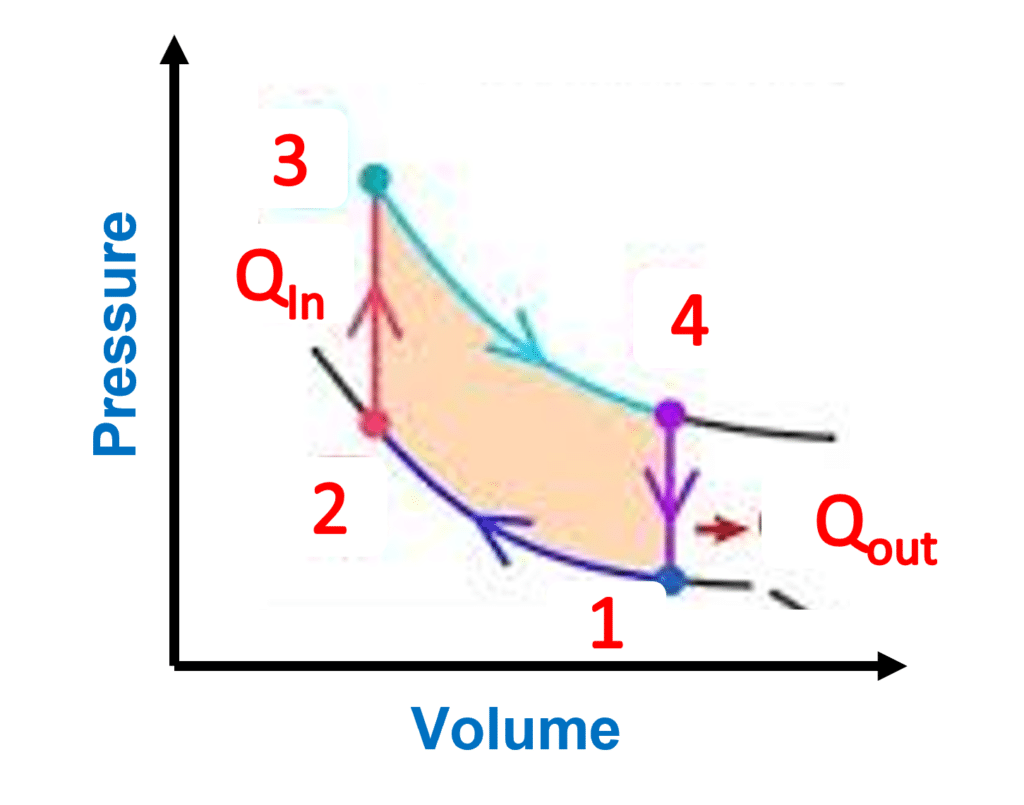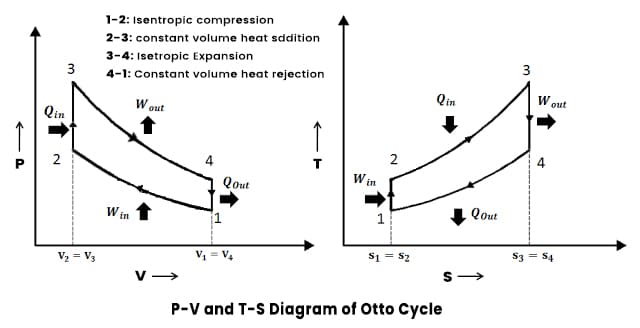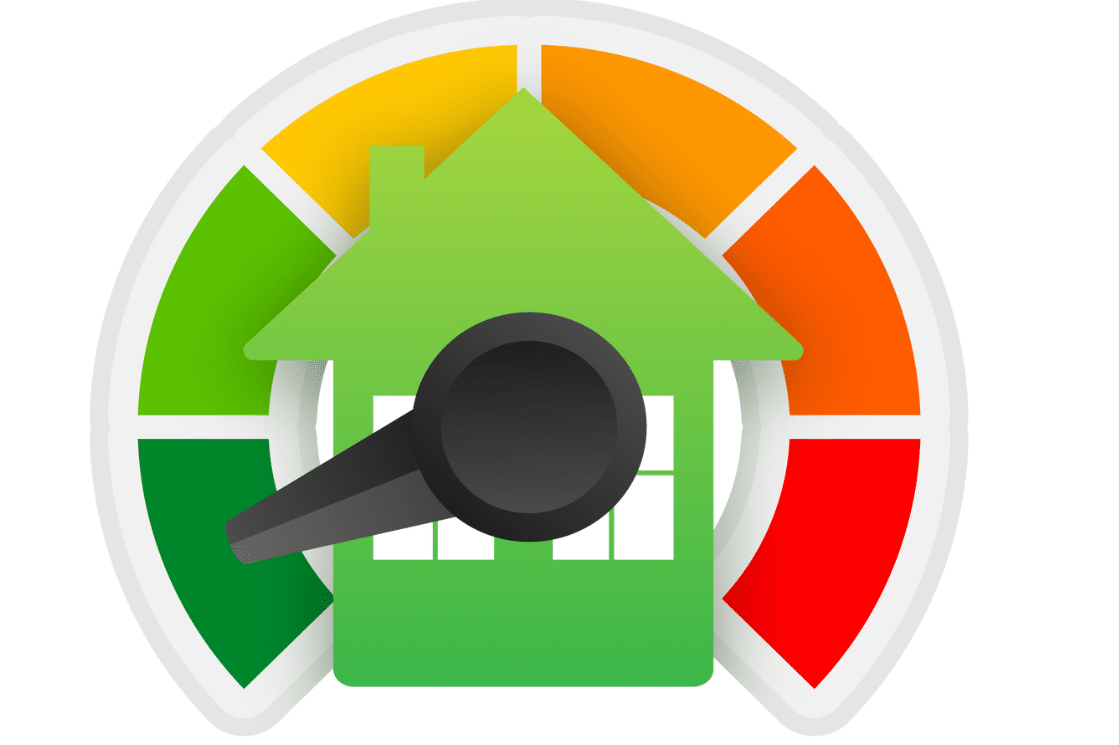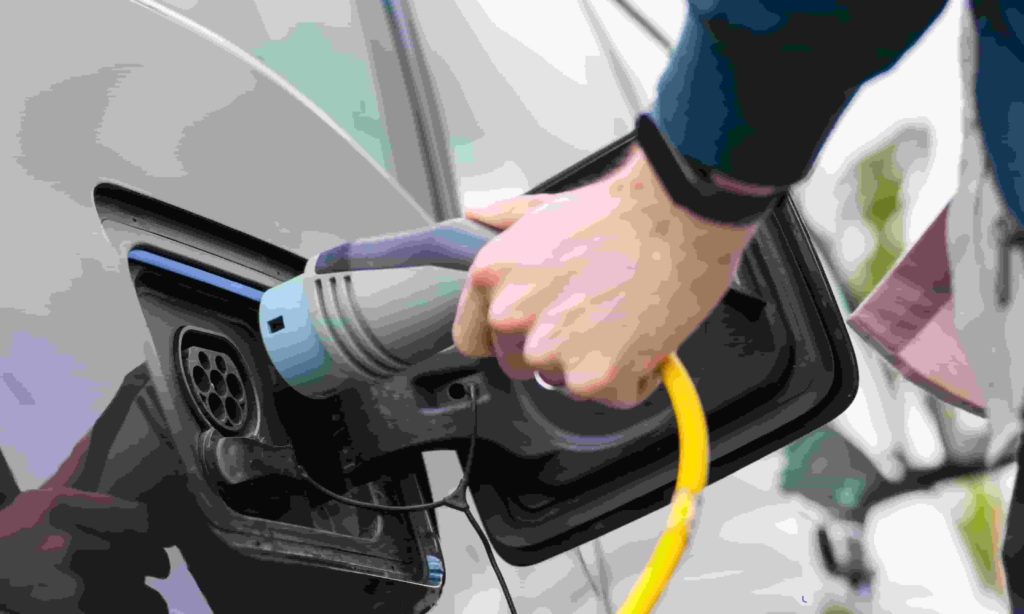The Otto Cycle shows how heat engines generate motion from fuel. This cycle, like other thermodynamic cycles, converts chemical energy into thermal energy and ultimately into motion (work). The Otto cycle outlines how internal combustion engines (gasoline engines, diesel engines, gas-turbine engines) function.
In technical terms, The Otto cycle is a set of processes employed by internal combustion engines that use spark ignition (2-stroke or 4-stroke cycles). These engines consume a fuel-air mixture, compress it, and cause it to react, creating heat by converting chemical energy into thermal energy, expanding the combustion products, and then expelling the combustion products and replacing them with a new charge of fuel and air.
Table of Contents
The IDeal Otto Cycle (PV-Diagram)
The Otto cycle describes what occurs to a mass of gas when it is subjected to variations in pressure, temperature, volume, heat addition, and heat removal. The PV diagram below clearly shows that as the piston works on the air-fuel combination, the volume of the gas reduces (compresses) and the pressure rises. Similarly, following combustion, the heat generated by the mixture does work on the piston, causing it to expand (the expansion process) and propel the vehicle.
The four-stroke Otto cycle is made up of the following four internally reversible processes:
- Step 1–>2: Isentric compression
- Step 2–>3: Constant volume combustion
- Step 3–> 4: Isentropic expansion
- Step 4–>1: Constant volume heat rejection

Step 1-2: Isentropic Compression
The piston is moved from TDC to BDC throughout this procedure. During the suction stroke, the air drawn into the cylinder undergoes reversible adiabatic (isentropic) compression. Because the air is compressed, the pressure rises from P1 to P2, the volume falls from V1 to V2, the temperature rises from T1 to T2, and the entropy remains constant.
Step 2-3: Constant volume combustion
This is an isochoric process, which means that heat is introduced to the air at a constant volume. In this procedure, the piston rests for a brief while at TDC, during which time heat is delivered to the air by an external source. Because of the heat addition, the pressure rises from P2 to P3, the volume remains constant (i.e. V2=V3), the temperature rises from T2 to T3, and the entropy rises from S2 to S3.

Step 3-4: Isentropic expansion
The isentropic (reversible adiabatic) expansion of air occurs throughout this phase. The piston transitions from TDC to BDC. This process generates power, which is then used to do a task. Because this process involves air expansion, the pressure lowers from P3 to P4, the volume grows from V3 to V4, the temperature reduces from T3 to T4, and the entropy remains constant (i.e. S3=S4).
Step 1-1: Constant volume heat rejection
In this procedure, the piston rests for a brief duration at BDC, and heat rejection occurs at a constant volume. The pressure reduces from P4 to P1, the volume remains constant (V4=V1), and the temperature decreases from T4 to T1.
When this cycle is employed in a four-stroke gasoline engine, two processes increase. One is the suction of the air-fuel combination within the cylinder, which occurs at constant atmospheric pressure, and the other is the exhaust of gases from the engine cylinder, which also occurs at constant atmospheric pressure.
Advantages and Disadvantages of Otto Cycle
| Advantages | Disadvantages |
| Good reliability | Low compression ratio |
| Engine (i.e., petrol engine) in which the Otto cycle is used has a low cost. | Less efficient than the Diesel cycle |
| Working medium (i.e., petrol) used for the working of this cycle has a low cost. | The cycle is not best for engines (i.e., diesel engines) of heavy vehicles. This has low efficiency. |
| Outstanding power to weight ratio | For combustion of the air-fuel mixture, it needs an additional spark plug which increases its cost. |
Daily Life Examples of Otto Cycle
- Driving a car or motorcycle that runs on gasoline
- Mowing the lawn with a gasoline-powered lawnmower
- Using a generator that runs on gasoline
- Operating a recreational vehicle or boat with a gasoline engine
- Riding a jet ski or snowmobile with a gasoline engine
Summary
- The Otto cycle is a thermodynamic cycle used by spark ignition engines, such as gasoline engines, to convert fuel into work.
- It consists of four processes: intake, compression, power, and exhaust.
- During the intake process, the fuel/air mixture is drawn into the cylinder.
- During the compression process, the mixture is compressed to a small fraction of its original volume, resulting in a high temperature and pressure.
- During the power process, the spark plug ignites the mixture, causing it to rapidly expand and produce work.
- During the exhaust process, the burned gases are expelled from the cylinder.
- The ideal gas law is used to model the behavior of the gas during the compression and expansion processes, allowing for the calculation of pressure, volume, temperature, and work.
- Factors that can cause the efficiency of an Otto cycle engine to decrease include incomplete combustion, heat loss to the environment, friction, and inefficient airflow.
- The addition of a turbocharger or supercharger can increase the amount of air entering the engine, which can result in a higher power output.
- The spark plug provides a spark that ignites the fuel/air mixture in the combustion chamber during the power process of the Otto cycle.
Exams Related Questions
| # | Question | Answer |
|---|---|---|
| 1 | What is the Otto cycle and how is it different from the Diesel cycle? | The Otto cycle is a thermodynamic cycle used by spark ignition engines, such as gasoline engines, to convert fuel into work. It consists of four processes: intake, compression, power, and exhaust. The Diesel cycle is similar but is used by compression ignition engines, such as diesel engines. The main difference is that the Diesel cycle involves a combustion process during constant pressure, whereas the Otto cycle involves a combustion process during constant volume. |
| 2 | Describe the four processes that occur during the Otto cycle. | The four processes that occur during the Otto cycle are intake, compression, power, and exhaust. During the intake process, the fuel/air mixture is drawn into the cylinder. During the compression process, the mixture is compressed to a small fraction of its original volume, resulting in a high temperature and pressure. During the power process, the spark plug ignites the mixture, causing it to rapidly expand and produce work. During the exhaust process, the burned gases are expelled from the cylinder. |
| 3 | What is the ideal gas law and how is it applied in the analysis of the Otto cycle? | The ideal gas law is PV=nRT, where P is pressure, V is volume, n is the number of moles of gas, R is the universal gas constant, and T is temperature. It is used to analyze the behavior of gases under different conditions. In the Otto cycle, the ideal gas law is used to model the behavior of the gas during the compression and expansion processes, allowing for the calculation of pressure, volume, temperature, and work. |
| 5 | How does the use of higher octane fuels affect the efficiency of the Otto cycle? | Higher octane fuels allow for a higher compression ratio in the engine, which can increase the efficiency of the Otto cycle. This is because higher compression ratios result in a higher temperature and pressure during the combustion process, which can result in more work output. However, if the engine is not designed to handle the higher octane fuel, it may not be able to take advantage of these benefits. |
| 6 | What factors can cause the efficiency of an Otto cycle engine to decrease? | Factors that can cause the efficiency of an Otto cycle engine to decrease include incomplete combustion, heat loss to the environment, friction, and inefficient airflow. Incomplete combustion can result in wasted fuel, while heat loss to the environment can reduce the temperature and pressure during the combustion process. Friction can cause energy losses in the engine, while inefficient airflow can lead to incomplete combustion and reduced power output. |
| 7 | How does the addition of a turbocharger or supercharger affect the performance of an Otto cycle engine? | The addition of a turbocharger or supercharger can increase the amount of air entering the engine, which can result in a higher power output. This is because the more air that enters the engine, the more fuel can be burned, resulting in more work output. Additionally, a turbocharger or supercharger can increase the engine’s efficiency by compressing the air before it enters the engine, allowing for a higher compression ratio and more efficient combustion. |
| 8 | What is the role of the spark plug in the Otto cycle engine? | The spark plug provides a spark that ignites the fuel/air mixture in the combustion chamber during the power process of the Otto cycle. The spark plug must be timed correctly so that it ignites the mixture at the right time in the cycle, allowing for the most efficient combustion possible. |
Related Links
Heat Flux-An Overview
Thermite Welding- An Overview
Power Units- The Basics
Thermal Energy Equation- Simple Overview
Momentum Equation| Definition and Examples
Frequently Asked Questions
1. What is the otto engine?
The Otto engine’s cycle is known as the Otto cycle. It is one of the most prevalent thermodynamic cycles seen in automotive engines and depicts how a standard spark ignition piston engine works. The Otto cycle, unlike the Carnot cycle, does not undertake isothermal procedures since they must be done extremely slowly. The system performing an ideal Otto cycle goes through a sequence of four internally reversible processes: two isentropic (reversible adiabatic) processes alternating with two isochoric processes.
2. What is an ideal otto cycle?
In an ideal Otto cycle, there is no heat entering (or leaving) the gas during the compression and power strokes, no friction losses, and instantaneous burning at constant volume. In reality, the ideal cycle does not exist, and each phase suffers a number of losses.
3. What is the difference between Otto and the diesel cycle?
The Otto cycle has a lower compression ratio (7:1 to 10:1), but the diesel cycle has a high compression ratio (11:1 to 22:1). Heat rejection occurs at a constant volume in both the Otto and diesel cycles. The Otto cycle has a lower efficiency than the Diesel cycle.
More Interesting Links
- BCl3 Lewis Structure in four simple steps - November 1, 2023
- PH3 Lewis Structure in four simple steps - October 8, 2023
- PF3 Lewis structure in four simple steps - September 24, 2023



